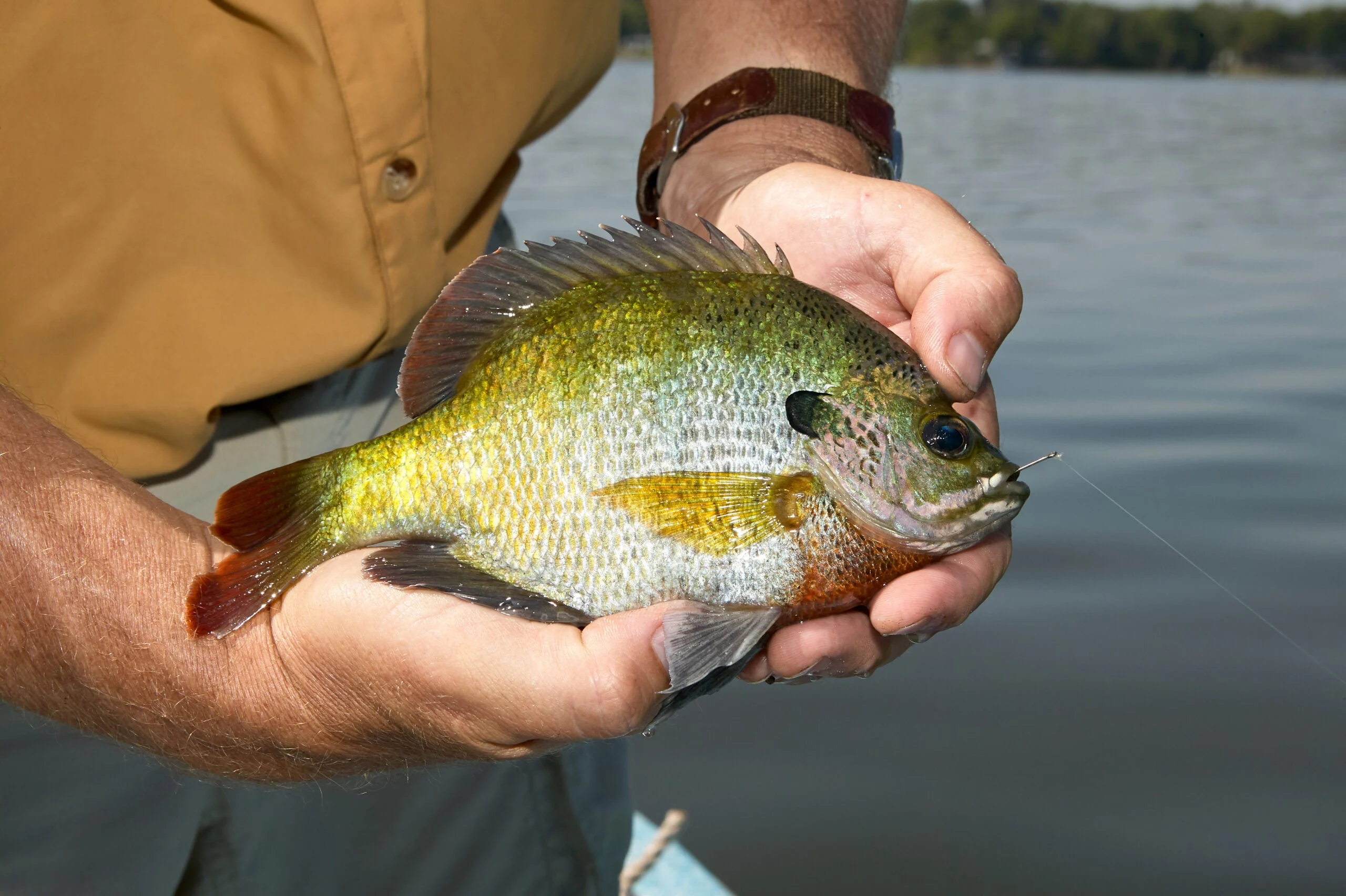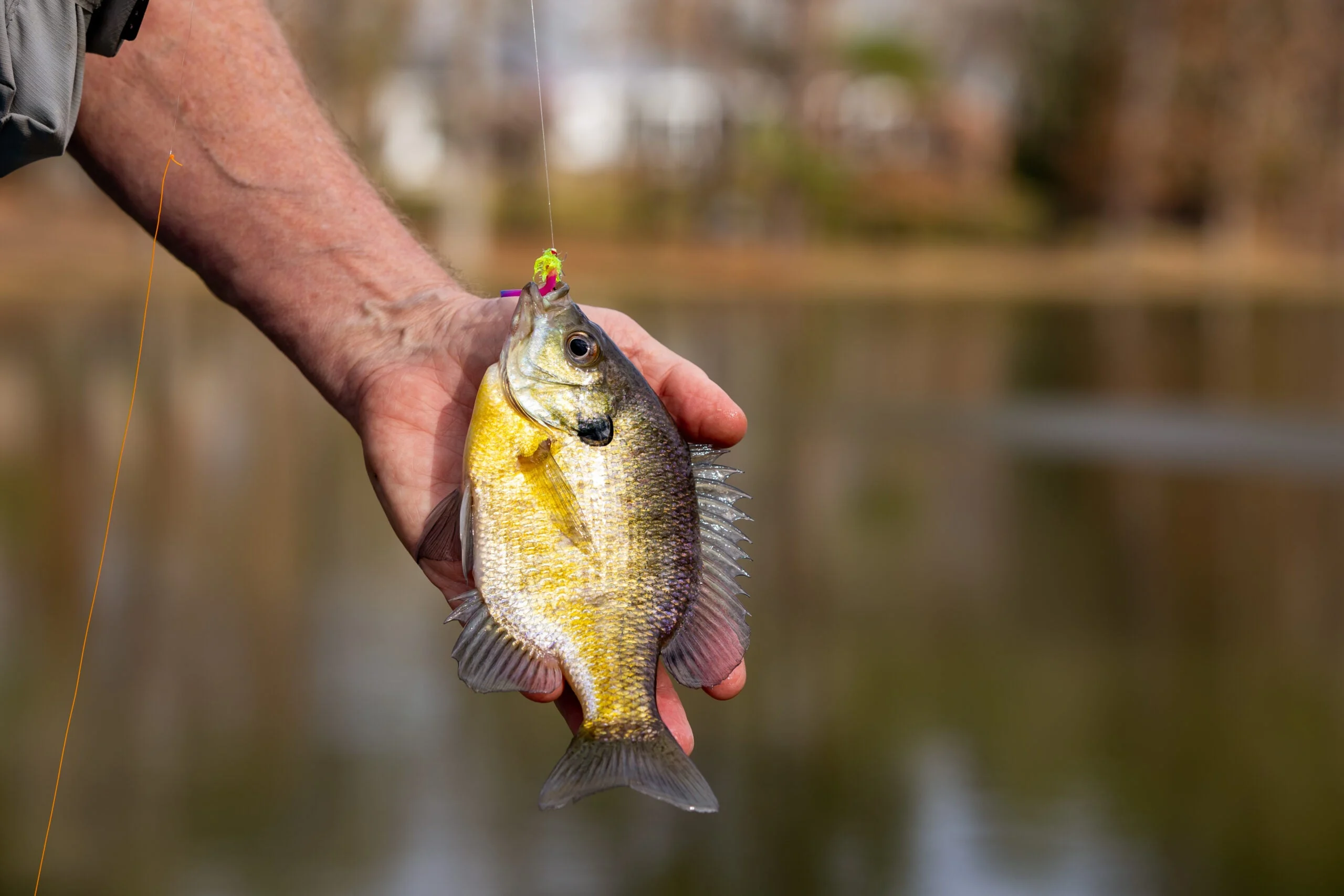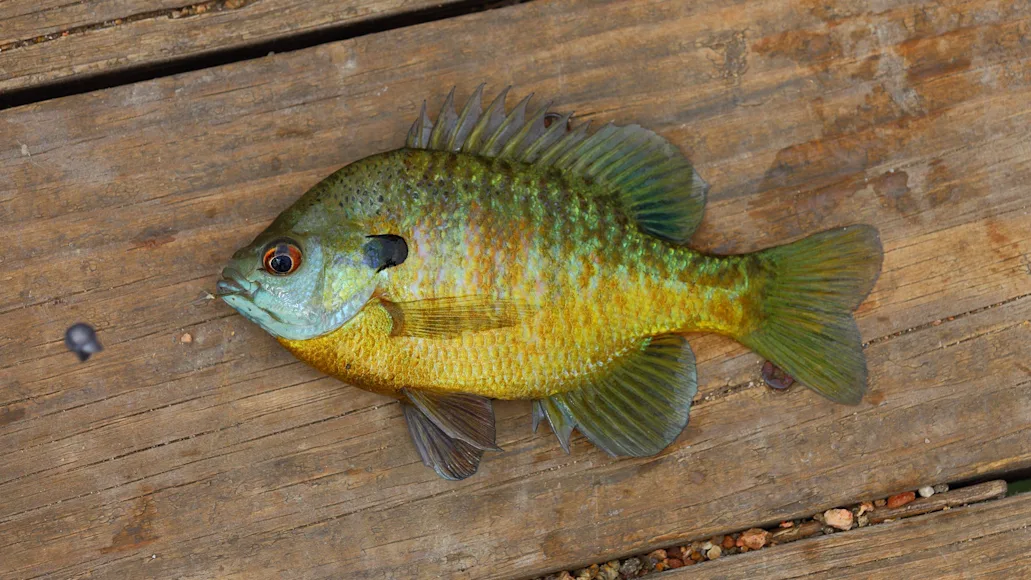If you’re wondering about sunfish vs bluegill, there’s something we should probably get straightened out right off the bat. Run a background check on bluegill, and you’ll see they’re actually a member of the sunfish family—a diverse clan widely distributed through North America’s fresh waters. This group includes well-known and commonly targeted species like redear, red breast, green, spotted, and longer sunfish, along with fliers and pumpkinseeds. However, most anglers consider bluegill the sunfish MVP.
Biologists know them as Lepomis macrochirus, while regional nicknames include bream, sunny, and inaccurately, perch. By any moniker, the bluegill enjoys top-shelf status among its sunfish kin. So, in case you get into a heated debate at fish camp about sunfish vs bluegill, here is everything you need to know to debunk your fishing buddies.
Appearance and Identification
A boldly photogenic fish, the bluegill takes its name from the blue tones accenting the lower portion of its jaw and gill covers. The deep, flattened body draws to a blunt head, with a relatively small mouth slanting downward, but not reaching as far back as the eyes.
Bluegill have a short, broad ear flap that’s dark blue/black, while their typically greenish-brown sides hold several dark, vertical bands. During the breeding season, males become bluish-green with darker bars and bright blue tones on the head and rusty orange chests. In any season, females are usually lighter in color.
We aren’t putting down the other sunfish, as many boast catch-worthy size and aggression. But there’s a reason Texas A&M’s AgriLife Extension
touts the bluegill as the most common forage fish stocked in southern farm ponds. Growth rates, spawning success, and bass appeal certainly matter here, but for anglers, the bluegill brings a lot more to the table.
For clarity, the sunfish family also includes the black bass gang, along with the ‘tweener species, like black and white crappie. To keep it apples-to-apples, we’ll focus on why bluegill tops the family’s more numerous branches, casually known as panfish.

Bluegills get their name from the blue tones accenting the lower portion of their jaw and gill covers. Colby/Adobe Stock
Availability & Access
Native to much of the eastern and central U.S., stocking and other introductions have enabled bluegill to find their way across the country and into Hawaii and Puerto Rico. The U.S. Geological Survey states the bluegill’s native range as the St. Lawrence-Great Lakes and Mississippi River basins from Quebec and New York to Minnesota and south to the Gulf, as well as the Atlantic and Gulf Slope drainages from the Cape Fear River, Virginia, to the Rio Grande, Texas, New Mexico, and northern Mexico.
It is important to note Florida also has a native subspecies known as the coppernose bluegill (L. macrochirus purpurascens) that’s commonly raised and sold for southeastern pond stocking. During the breeding season, a male coppernose displays a purplish head and a copper-colored band across the head above the eyes.
“I think bluegill is the (sunfish) species that people fish for the most due to its widespread range,” said Allen Martin, Regional Fisheries Administrator for the Florida Fish and Wildlife Conservation Commission. “You can catch them just about everywhere.”
As Martin notes, the green sunfish (aka goggle-eye, rock bass, or branch perch), while not present in Florida, also boasts a nationwide distribution, second only to the bluegill. The two often occur adjacently, but in terms of angler access, the green sunfish tends to spend more time deeper, while the bluegill may feed from inches of shoreline water out to deep weed beds in 12 feet or more.
As for water bodies, the bluegill shows tremendous diversity by thriving in everything from large natural lakes to reservoirs, rivers, and even retention ponds. Storm drains and seasonal overflows always seem to boost the bluegill’s expansion. Ideal for land-based anglers—especially kids and beginners—bluegill often show themselves around shallow vegetation, docks, sea walls, and open water along lightly trafficked shorelines.
Tips and Tactics
Schools of 5 to 10 bluegill are common, while larger aggregations can occur, especially during prime feeding scenarios. Sight-feeding omnivores, these premier panfish consume aquatic vegetation, zooplankton, insect larvae, insects, invertebrates, fish eggs, minnows, and other small fish.
“It’s pretty simple fishing and one of the first fish you take a kid to catch”, said Martin. “From an angling standpoint, they bite pretty regularly and eat a wide variety of baits.”
When it comes to targeting these gluttons
, anglers equipped with small hooks, split shots, bobbers, and their choice of crickets, earthworms, or bread balls will fare well. While those seeking higher sport may use small jigs under slip floats, tiny crankbaits, jerk baits, and flies (insect patterns and poppers). Through the ice, a tiny tungsten jig tipped with maggots is the ticket.
Want to find out if your area holds bluegill? Chum the water with pieces of sliced bread. The turtles and ducks will eventually grab their share, but bluegills are not bashful, so look for the swirls and pops to judge quality and quantity.
“Bluegill will fight super hard for their size, often spinning in circles and wrapping an angler’s line on vegetation or brush,” said Minnesota guide Brian “Bro” Brosdahl. “That makes them a formidable battle on light line.”

Anglers pursue bluegills with conventional, fly, and ice fishing gear. Chad Robertson
A Worthy Target
While loads of smaller bluegill provide nearly non-stop fun for kids with cane poles or spincast tackle, serious anglers willing to put in the effort can find hefty “eater” size ‘gills in open water and through the ice. The U.S. Fish & Wildlife Service says 7 1/2 inches is a common size, but ‘gills in prime growing scenarios may reach 16 inches. The IGFA all-tackle world record was a 4-pound, 12-ounce whopper caught on April 9, 1950, on Alabama’s Ketona Lake.
In terms of size potential, redear sunfish (aka Shellcracker) may exhibit regionally superior growth. Arizona’s Lake Havasu comes to mind, with the IGFA all-tackle world record standing at 6 pounds, 4 ounces (caught May 4, 2021). On average, though, bluegill can hold their own against redear.
Here’s a quick way to distinguish the two species: the redear’s dark ear flap includes a red border, and the sides have more of a golden, often speckled, coloration with vertical banding much fainter than that of a bluegill.
Table Fare
Bluegills offer delicate white meat second only to the crappie in the panfish options. For optimal quality, keep your catch fresh on ice until cleaning time. Brosdahl urges anglers to release the larger bluegill for spawning and nest-guarding duties. A limit of medium-sized ‘gills can make for a dandy fish fry. Some filet their bluegill, but old-schoolers scale and gut their fish, then coat in corn meal and fry until golden brown. Hold the tail and pick the flaky white meat right off the bones. Hot sauce is optional, but hush puppies are mandatory.





